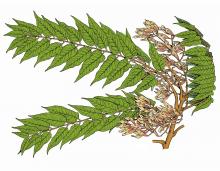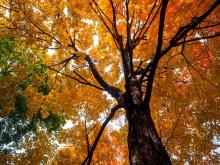Trees, Shrubs and Woody Vines
Media

Species Types
Scientific Name
Fraxinus pennsylvanica
Description
Green ash is one of the most widely planted shade trees around homes and along streets. In the wild, it lives along streams and in low grounds. Sadly, it is one of the trees most vulnerable to the emerald ash borer, an exotic invasive pest.
Media

Species Types
Scientific Name
Fraxinus americana
Description
White ash leaves turn shades of yellow and purple in fall, and that is one reason it has been a popular landscaping tree. Many birds and mammals feed on the paddle-shaped seeds.
Media

Species Types
Scientific Name
Acer rubrum
Description
Red maple is one of our most useful — and beautiful — native trees. You can find it in the woods as well as in landscape plantings statewide. Many horticultural varieties are available at nurseries.
Media

Species Types
Scientific Name
Acer saccharinum
Description
In nature, silver maple is a bottomland tree. Silver maples pay for their rapid growth by having rather brittle branches that easily break off in windy and other inclement weather.
Media

Species Types
Scientific Name
Acer negundo
Description
A member of the maple family, box elder is often confused with poison ivy because its compound leaves sometimes grow in threes (though also in fives). A fast-growing tree, its winged seeds betray its relationship to other maples.
Media

Species Types
Scientific Name
Ulmus rubra
Description
Found nearly statewide, slippery elm has fuzzy twigs and reddish hairy buds, which often attract attention in wintertime. Its inner bark is reddish and rather slimy, which gives this tree its name "slippery."
Media

Species Types
Scientific Name
Salix spp. (about 12 species in Missouri)
Description
Exotic willows are available at lawn and garden centers, but there are several willow species that are native to Missouri. Most are rather humble colonizers of gravel bars, riverbanks, and lakesides. Many are important for human economic interests. All have a place in our wild ecosystems.
Media

Species Types
Scientific Name
Ailanthus altissima
Description
Tree-of-heaven is a fast-growing exotic that is common in urban areas. It is weedy and aggressive and should not be planted. It has 2-foot-long feather-compound leaves. Twigs smell unpleasant when you break them.
Media

Species Types
Scientific Name
Brunnichia ovata (formerly B. cirrhosa)
Description
Ladies’ eardrops is a perennial, tendril-climbing woody vine to 40 feet, with green to reddish-brown stems, and curious pink, pendant fruits. In Missouri, it is found in the Bootheel.
Media

Species Types
Scientific Name
Acer spp.
Description
Missouri has five species of maples that are either native or naturalized, plus several that are known only in cultivation. Maples are important members of native ecosystems. They also provide stunning fall color, welcome shade in summer, commercially important lumber, and sap for syrup.
See Also
About Trees, Shrubs and Woody Vines in Missouri
There are no sharp dividing lines between trees, shrubs, and woody vines, or even between woody and nonwoody plants. “Wood” is a type of tissue made of cellulose and lignin that many plants develop as they mature — whether they are “woody” or not. Trees are woody plants over 13 feet tall with a single trunk. Shrubs are less than 13 feet tall, with multiple stems. Vines require support or else sprawl over the ground.





















